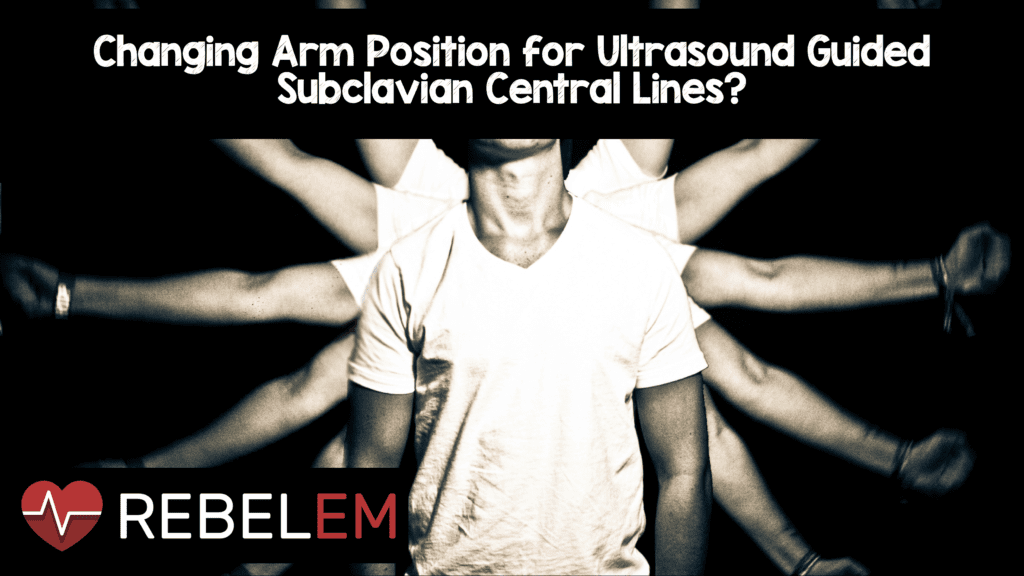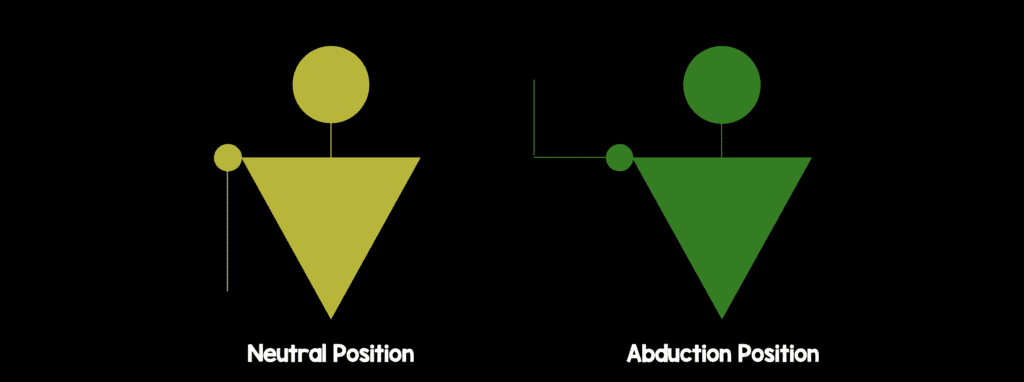
 The subclavian route is known to be the site for central line placement with the lowest risk of infection, but can also lead to many mechanical complications [2]. The biggest risk of subclavian line placement is an iatrogenic pneumothorax. The use of ultrasound for subclavian line placement can greatly reduce this risk by watching the needle enter the vein. But does arm position matter for ultrasound guided subclavian central lines?
The subclavian route is known to be the site for central line placement with the lowest risk of infection, but can also lead to many mechanical complications [2]. The biggest risk of subclavian line placement is an iatrogenic pneumothorax. The use of ultrasound for subclavian line placement can greatly reduce this risk by watching the needle enter the vein. But does arm position matter for ultrasound guided subclavian central lines?
The article attempting to answer this question is currently in press, entitled “The Influence of Arm Positioning on Ultrasonic Visualization of the Subclavian Vein: An Anatomical Ultrasound Study in Healthy Volunteers” (Anesth Analg 2016).
What They Did:
- Anatomic ultrasound study of healthy, nonpregnant volunteers aged 18-50 (n=50)
- Excluded those with history of local surgery or trauma or arm deep venous thrombosis
- One anesthetist obtained all images. Second, blinded ultrasound vascular expert made all measurements
Ultrasound Technique:
- All measurements were performed with the patient in a supine position, on the right side only, with a 7.5 MHz linear probe
- Probes were placed parallel to the clavicle in the infraclavicular position
- Ultrasound images obtained in two arm positions
- Arm in neutral position (by the patient’s side)
- Arm in 90° abduction, 90° flexion, and 90° external rotation

Outcomes:
- Cross-sectional area of the subclavian vein in neutral position compared to the abducted position
- Also measured the minimal distance between the vein to the skin, adjacent subclavian artery, and pleura
Results:
- Abducted arm position increased cross-sectional area of the vein in 75% of volunteers (difference of 36 ± 75 mm2, p=0.001)
- Abducted arm position increased cross-sectional area of the vein by ≥50% in at least 27% of volunteers
- Depth of the vein was reduced in the abducted position by a difference of -2 ± 4 mm (p<0.001)
- There was no difference in the distances to the subclavian artery or pleura
Limitations:
- Anatomic study only, no attempts at venipuncture
- Healthy volunteers may differ from critically ill patients (i.e. mechanically ventilated)
- No obese patients were included
- A specific device was used to keep the arm in the abducted position
- Only the right subclavian vein was study (“this study cannot exclude different conclusions for the left side”)
Strengths:
- A 2nd independent ultrasound expert, who was blinded to the arm position and the order of the images performed all measurements
This study, although small, provides some intriguing results. If a simple maneuver like arm positioning can make a significant difference in ultrasound visualization of the subclavian vein, theoretically, complications and failure rates of ultrasound guided subclavian venipuncture could be reduced. A follow up study in critically ill patients using the left side with associated venipuncture would be ideal to cement this maneuver into clinical practice.
Clinical Bottom Line:
During placement of a subclavian central venous catheter, placing the ipsilateral arm in 90° abduction, 90° flexion, and 90° external rotation can increase the cross-sectional area of the vein. This may assist in ultrasound-guided placement of the line, thereby reducing failure and complication rates, but external validation studies with clinically important and patient oriented outcomes are still needed before adopting this technique.
References:
- Sadek M, et al. The Influence of Arm Positioning on Ultrasonic Visualization of the Subclavian Vein: An Anatomical Ultrasound Study in Healthy Volunteers. Anesth Analg 2016. [epub ahead of print]. PMID: 27149016
- Parienti JJet al; 3 SITES Study Group. Intravascular Complications of Central Venous Catheterization by Insertion Site. NEJM 2015;373:1220–9. PMID: 26398070
Post Peer Reviewed By: Salim Rezaie (Twitter: @srrezaie)
The post Changing Arm Position for Ultrasound Guided Subclavian Central Lines? appeared first on REBEL EM - Emergency Medicine Blog.
